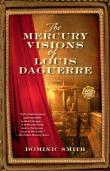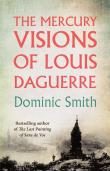AustLit
Latest Issues
AbstractHistoryArchive Description
'When the vision came, he was in the bathtub. So begins the madness of Louis Daguerre. In 1847, after a decade of using poisonous mercury vapors to cure his daguerreotype images, his mind is plagued by delusions. Believing that the world will end within one year, Daguerre creates his "Doomsday List"—ten items he must photograph before the final day. The list includes a portrait of Isobel Le Fournier, a woman he has always loved but not spoken to in half a century.
'In this luminous debut novel, Dominic Smith reinvents the life of one of photography's founding fathers. Louis Daguerre's story is set against the backdrop of a Paris prone to bohemian excess and social unrest. Poets and dandies debate art and style in the cafés while students and rebels fill the garrets with revolutionary talk and gun smoke. It is here, amid this strange and beguiling setting, that Louis Daguerre sets off to capture his doomsday subjects.
'Louis enlists the help of the womanizing poet Charles Baudelaire, known to the salon set as the "Prince of Clouds," and a jaded but beautiful prostitute named Pigeon. Together they scour the Paris underworld for images worthy of Daguerre's list. But Louis is also confronted by a chance to reunite with the only woman he's ever loved. Half a lifetime ago, Isobel Le Fournier kissed Louis Daguerre in a wine cave outside of Orléans. The result was a proposal, a rejection, and a misunderstanding that outlasted three kings and an emperor. Now, in the countdown to his apocalypse, Louis wants to understand why he has carried the memory of that kiss for so long.'
Source: Dominic Smith's website, http://www.dominicsmith.net/
Sighted: 15/02/2011
Notes
-
Dedication: For Mikaila and Gemma
-
Author's note: Although this is a work of fiction and the characters are inventions, I have borrowed details from the biographies of Charles Baudelaire, the poet, and Louis Daguerre, an early inventor of photography. Wherever possible (and expedient to the story) I have tried to capture the flavour of the real Daguerre's life and the historical context in which he achieved his fame. There are several books the were invaluable for aiding this process : L.J.M. Daguerre : The History of the Diorama and the Daguerreotype (1968) by Helmut and Alison Gernsheim; An Historical and Descriptive Account of the Various Processes of the Daguerreotype and the Diorama (1839), by Lois-Jacques-Mande Daguerre; Dickens's Dictionary of Paris (1890), by Charles Dickens; The Poem of Hashish (1895), by Charles Baudelaire; and The Hashish Club (1971), by Theophile Gautier. I also found many of the articles and resources on the Daguerreian Society's website (www.deguerre.org) to be useful.
Mercury vapors were used extensively by Louis Daguerre during his photographic career. His basic process was to expose a sensitized plate inside camera obscura, take the plate into a darkened room, then pass it back and forth above a heated mercury bath. Millions of tiny mercury drops settled over the image, fixing it permanently. The presence of mercury gives metal-plate daguerreotypes their luster and minute level of detail, but it can also lend them a ghostly. holographic appearance. The image can appear to change based on the eye-level and perspective of the viewer. in later years, as Daguerre tried to minimise exposure times in an attempt to capture faster paced movement (such as galloping horses and birds in flight) he experimented with increasingly deadly substances - cyanide of mercury, nitric acid, and gold chloride. Daguerre, who suffered from various physical complaints until he died of a heart attack in 1851, was probably unaware of how harmful such substances were.
The image on the original front jacket, known as The Vampire was taken by Chalres Negre circa 1853 using a paper negative process. The view is from the balustrade above the Grande Galerie of Notre Dame, looking north. The man in the photograph is Henri Le Secq, an artist friend of the photographer. Negre, like so many of his painter contemporaries, was inspired by Daguerre's process and began experimenting with various forms of photography, primarily as an aid to painting.
Publication Details of Only Known VersionEarliest 2 Known Versions of
-
Paris,
cFrance,cWestern Europe, Europe,
- 1847





